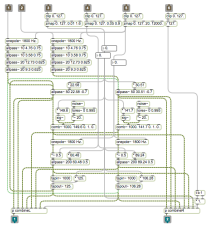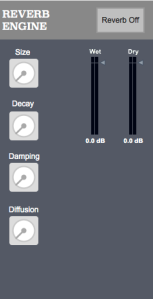Sound design, relies on the discretion of the designer to create a sound scape which is accurate to the atmosphere of the scene. This creating by manipualting the sounds to achieve the right fidelity. Reverberation plays a crucial role in the establishment of space. Reverberation of a sound determines helps the listener perceive the space in which the sound originated. However for the purpose this project, A multi-parameter reverb was required.
Research was conducted into the the different types of reverb. Selection of an optimum reverb was necessary so as to retain fidelity of the sound.Each parameter of reverb is essential in the modulation of reverb. However its was crucial to determine to key parameters. After much deliberation, the code for the reverb was adopted from the available in the Max/MSP reference section. This reverb, developed by — is based on the logic seen in a Lexicon Plate reverb. This reverb provides a variation of rich spaces.
The Reverb is a part of Max/MSP as a subpath under the object name yafr2~ which is developed by Randy Jones. this is a plate reverb in the style of the Griesinger Reverb (Lexicon).
The Tonal quality of the reverb provided was rich and therefore was adapted onto the patch to define the space in which the foley was taking place.
Although the attributes of the reverb seem complicated, the UI only looks at 5 factors; Dry/Wet, Size, Decay, Damping and Diffusion. these are the 5 main control features which allow the manipulation of the reverb. There is also in the front which allows users to bypass the reverb, when not needed therefore reducing DSP load on the core audio.

